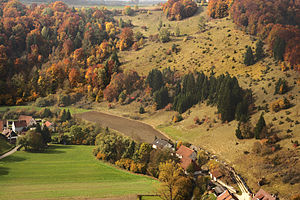Great Lautertal and regional court
|
FFH area
"Großes Lautertal and Regional Court" |
||
|
Juniper heather near Gundelfingen |
||
| location | Six cities and municipalities in the Reutlingen district and in the Alb-Donau district in Baden-Württemberg , Germany | |
| Identifier | DE-7622-341 | |
| WDPA ID | 555521979 | |
| Natura 2000 ID | DE7622341 | |
| FFH area | 3.371 km² | |
| Geographical location | 48 ° 20 ' N , 9 ° 30' E | |
|
|
||
| Setup date | January 1, 2005 | |
| administration | Regional Council Tübingen | |
The FFH area Großes Lautertal and Regional Court is a protected area (protected area identifier DE-7622-341) in the German state of Baden-Württemberg that was registered in 2005 by the Tübingen regional council according to Directive 92/43 / EEC (Fauna-Flora-Habitat Directive) . With the ordinance of the regional council of Tübingen on the definition of areas of community importance of November 5, 2018, the area was determined.
location
The 3371.5 hectare FFH area belongs to the natural areas 096- Middle Kuppenalb and 097- Middle surface Alb within the natural spatial unit 09 - Swabian Alb . It lies in the valley of the Große Lauter with side valleys from the source near Offenhausen to the confluence with the Danube near Lauterach.
- District Reutlingen:
- Gomadingen : 337.15 ha = 10%
- Hayingen : 472.01 ha = 14%
- Münsingen : 539.44 ha = 16%
- Hohenstein : 67.43 ha = 2%
- Alb-Danube district:
- Ehingen (Danube) : 1314.885 ha = 39%
- Lauterach : 606.87 ha = 18%
Description and purpose of protection
The Lautertal winds strongly and is limited by steep slopes with rock formations. It is determined by limestone grasslands. There are 65 caves in the area.
Habitat classes
(general characteristics of the area) (percentage of total area)
Information according to the standard data sheet from the Official Journal of the European Union
| N06 - inland waters (standing and flowing) | 1 % | |||
| N07 - moors, swamps, bank vegetation | 1 % | |||
| N09 - dry grassland, steppes | 8th % | |||
| N10 - Moist and mesophilic grassland | 9% | |||
| N14 - Meliorated grassland | 1 % | |||
| N15 - Other farmland | 1 % | |||
| N16 - deciduous forest | 61% | |||
| N17 - coniferous forest | 2% | |||
| N19 - mixed forest | 16% | |||
Habitat types
In accordance with Appendix 1 of the Tübingen Regional Council's ordinance on the definition of areas of Community importance (Habitats Ordinance) of 5 November 2018, the following habitat types according to Annex I of the Habitats Directive occur in the area:
| EU code |
Habitat type (official name) | Short name | Hectares |
|---|---|---|---|
| 3260 | Rivers of the planar to montane level with vegetation of the Ranunculion fluitantis and the Callitricho-Batrachion | Running waters with flooding water vegetation | 15.00 |
| 5130 | Formations of Juniperus communis on limestone heaths and lawns | Juniper Heath | 159.87 |
| 6110 | Gap basophilic or lime pioneer lawn (Alysso-Sedion albi) | Lime pioneer lawn | 1.00 |
| 6210 | Near-natural dry lime lawns and their stages of shrubbery (Festuco-Brometalia) | Lime grassland | 17.15 |
| 6430 | Moist tall herbaceous vegetation of the planar and montane to alpine levels | Moist tall herbaceous vegetation | 3.00 |
| 6510 | Lean lowland hay meadows (Alopecurus pratensis, Sanguisorbaofficinalis) | Lean, lowland hay meadows | 12.41 |
| 6520 | Mountain hay meadows | Mountain hay meadows | 0.92 |
| 7220 | Tufa springs (cratoneurion) | Tufa springs | 0.11 |
| 8160 | Calcareous debris heaps of the colline bismontane level of Central Europe | Lime debris heaps | 1.00 |
| 8210 | Limestone cliffs with crevice vegetation | Limestone cliffs with crevice vegetation | 10.12 |
| 8310 | Caves that are not open to tourists | caves | 0.001 |
| 9130 | Woodruff beech forest (Asperulo-Fagetum) | Woodruff beech forest | 1940.50 |
| 9150 | Central European orchid-lime-beech forest (Cephalanthero-Fagion) | Orchid beech forests | 86.40 |
| 9180 | Tilio-Acerion canyon and slope mixed forests | Mixed ravine and hillside forests | 88.80 |
| 91E0 | Alluvial forests with Alnus glutinosa and Fraxinus excelsior (Alno-Padion, Alnion incanae, Salicion albae) | Alluvial forests with alder, ash, willow | 3.50 |
Contiguous protected areas
The FFH area consists of 14 sub-areas. In large parts it overlaps with several landscape protection areas . The bird sanctuary 7624-441 valleys of the Middle Alb has around 42 percent shares in the FFH area. 79 percent of it is also located in the Swabian Alb biosphere area .
The nature reserves lie within the area
- 4197- Blasenberg-Ringelesberg
- 4246- Buttenhausen Eichhalde
- 4124- Eichholz
- 4313- Danube meadows between Zwiefaltendorf and Munderkingen
- 4249- Geissberg
- 4253- Hüttenstuhlburren
- 4126- Krähberg-Kapellenberg
- 4125 Stone Hump
See also
Web links
- Data evaluation sheet and map in the profile of the FFH area in the protected area directory of the LUBW
- Profile of the Natura 2000 area 7622-341 Großes Lautertal and regional court (FFH area) at the Federal Agency for Nature Conservation

